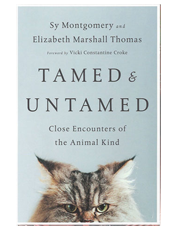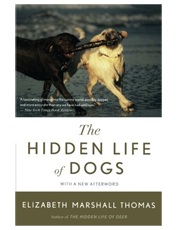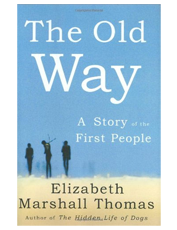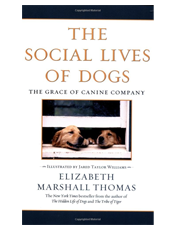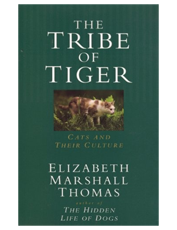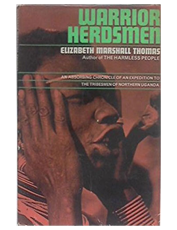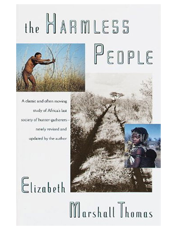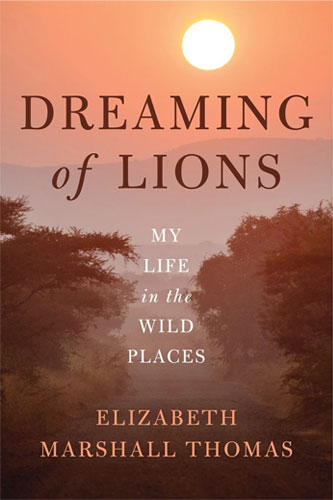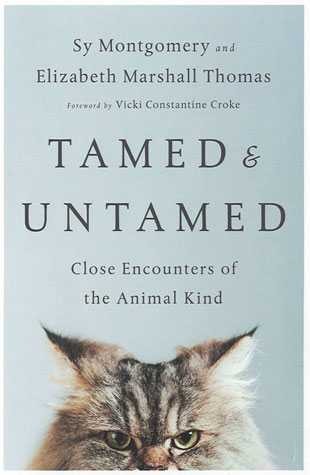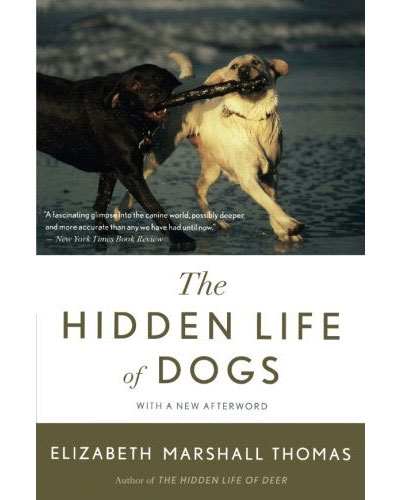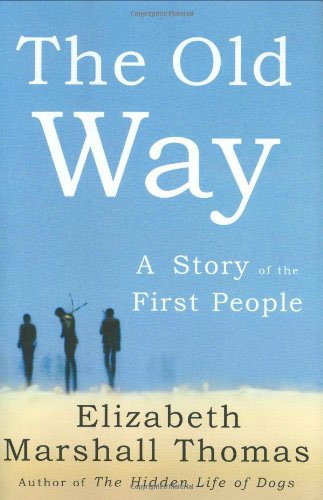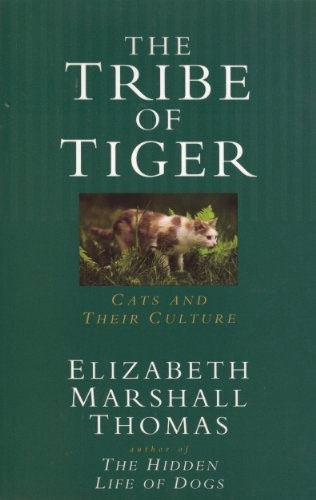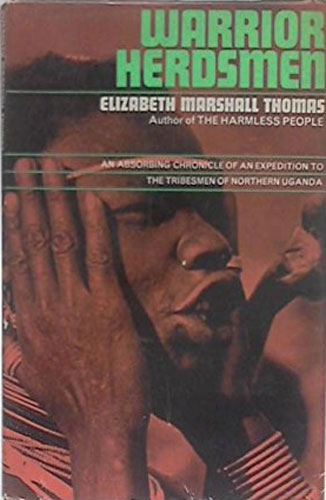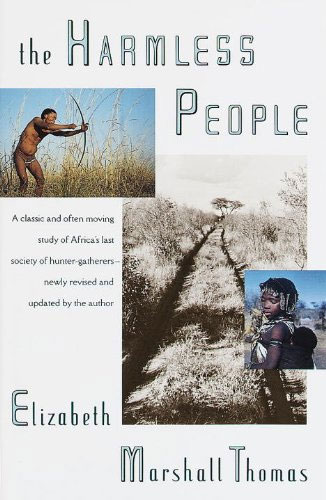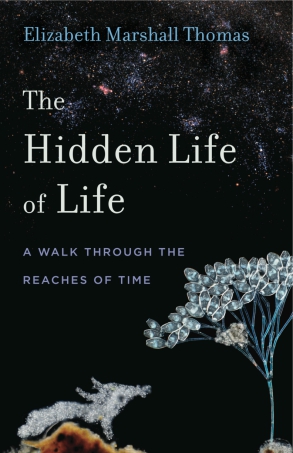The Social Life of Dogs
The Grace of Canine Company
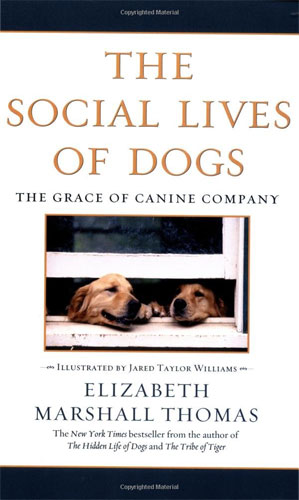 ISBN-13: 9780743422369
ISBN-13: 9780743422369
Publisher: Gallery Books
Publication date: 06/01/2001
Pages: 256
Product dimensions: 0.58(w) x 5.00(h) x 8.00(d)
Amazon
Barnes & Noble
Better World Books
Indie Bound
Toadstool Bookshops
The Social Lives of Dogs
The Grace of Canine Company
The New York Times
Caroline Knapp
Among dog people, the name Elizabeth Marshall Thomas is a bit of a Rorschach test, with associations all over the map. To some dog owners, she’s a genius, a guru, a woman with the keys to the canine city. So many of us want to know what really goes on in those baffling, beloved dog brains — what motivates dogs, how they think and feel — and Thomas’s 1993 best seller, ”The Hidden Life of Dogs,” seemed to deliver the goods: here was a woman, an anthropologist no less, who lived with 11 dogs, observed them daily, actually followed them around on a bicycle to see what they did when left to their own devices. [expand title=”Show More”] But if the result — an insider’s look at the politics of hierarchy and territoriality that so define canine life — gratified some, it infuriated others. Scientists — particularly those who don’t believe that animals are capable of feeling in the first place — condemned the book as an exercise in anthropomorphic pseudoscience. Spying on dogs? On a bicycle? Please. And to a third camp, the whole thing smacked of irresponsibility: 11 dogs, the males unneutered, all of them allowed to run loose in the city — this sounded less like an anthropological field study than a recipe for chaos.
Thomas’s sequel, ”The Social Lives of Dogs,” picks up where its predecessor left off — it describes life amid the pack she acquired after her original 11 began to die off — and while critics from the hard sciences will still bristle at her sense of dog psychology, the rest of us will be delighted, some because Thomas brings the same degree of observational precision to this project and some for a more pragmatic reason: the author has moved her show to rural New Hampshire, where the dogs are safer.
The new pack begins with Sundog, a large white stray Thomas discovered during a visit to the city; over time, the pack swells to include five humans, seven dogs, nine cats and five parrots. This ”churning caldron of a household” becomes Thomas’s live-in laboratory, a place of extraordinary ordinariness: nothing very remarkable happens unless you believe, with the author, that everything dogs do is remarkable, and then life among them becomes endlessly fascinating. How do different dogs react when you place a biscuit under a cloth, thus presenting a problem to solve? How does an underconfident dog learn to negotiate stairs? How do country dogs react when taken on a trip to Manhattan? (Answer: unable to see trees or sky or dirt, they seem to think it’s a giant building, which causes considerable distress on the bladder front; being good dogs, they refuse to relieve themselves indoors.)
These are the kinds of quirky details Thomas explored the first time around, and she’s masterly at description, equipped with a deep regard for the essential dogness of dogs and attuned to the tiny things — a wag here, an expression there — that capture who they are. But her take is more expansive here: this is a quieter, gentler Thomas, less of a dispassionate observer and more of an engaged participant in her dogs’ lives, and the result is a fuller, more affecting read.
What do dogs want? In ”The Hidden Life,” Thomas answered this question unequivocally: ”They want each other. Human beings are merely a cynomorphic substitute.” This may have been true of that pack — Thomas maintained a distance from those dogs that felt both geographic and emotional, as though their relationship to the human world (and her relationship to them) were secondary, if not beside the point. In this work, her greater emotional proximity to the dogs puts her on more richly textured territory, a place where field observation meets feeling.
She is still fascinated by dogs’ relationships with one another, and, as in ”The Hidden Life,” she vividly brings to life the dynamics of hierarchy and social longing that characterize them. We see how the confident, capable Sundog so easily maintains his status as the alpha male, and why Misty, a Belgian sheepdog who spent her puppyhood alone in a crate, remains so insecure about her position as Dog 2. We get carefully rendered glimpses of the affection that crops up inexplicably between some dogs (in one of the book’s sweeter passages, Sundog develops a fondness for an overweight beagle mix named Bean), and of the range of feeling — indifference, begrudging acceptance, competitiveness — that exists between others. We see dogs as dogs, with their own rules and codes of conduct.
But Thomas is equally attentive to the dog-human bonds that form within her household, and even the dog-cat and dog-cat-human bonds, and so we see dogs forming special alliances with particular people, and cats splitting off to join this subpack or that one; we see cats lying with dogs on their beds, wrapping their bodies around the dog’s head as a cat might cradle a kitten; we see how aware each species is of the other, and how many subtle accommodations the members must make in order to coexist. The reach in this book is larger, creating a sense of the deep and daily connection between human and dog — the mutuality of affection and need, the mysterious and pure sympathy that transcends language, the anguish of loss.
Thomas is still a controversial, eccentric character, and the book is not without its controversial, eccentric features. An epilogue on cross-species telepathy feels a bit strained; an appendix on keeping parrots feels like an unnecessary afterthought. The author also leaves herself open to some of the same criticism that followed ”The Hidden Life”: readers wary of anthropomorphism will groan when she speculates about whether Sundog, while masturbating, is engaged in a sexual fantasy; dog owners horrified by her laissez-faire approach to training may find her appendix on the control of dogs heavy-handed (in it, she rails against the ”iron hand of dog fascism” that she believes pervades American pet ownership). But Thomas has cracked open the door she first unlocked in ”The Hidden Life” by several degrees, and it’s worth peering past the barriers (too little science for some, too much dogma for others) to see what’s inside. There’s plenty of heart in this caldron. And, of course, lots of dogs.[/expand]
Simon & Schuster
In this sequel to her illuminating bestseller The Hidden Life of Dogs, Elizabeth Marshall Thomas profiles the canines in her own household to show how dogs have comfortably adapted to life with their human owners — and with each other. A classically trained anthropologist, she answers questions we all have about our pets’ behavior. Do dogs have different barks that mean different things? What makes a dog difficult to house-train? Why do certain dogs and cats get along so well? How does Snoopy recognize people he sees only once a year, while Misty barks at strangers she sees every day?
The Social Lives of Dogs presents marvelous evidence of the power of the group — and shows us that those who are fortunate enough to be given the trust of an honorable dog will also have their lives enriched.
Chapter One
Our group of mixed species began soon after my husband and I moved to New Hampshire from Virginia. Three dogs came with us, all very old, the only dogs who remained alive from a once much larger pack that, unlike most groups to which dogs belong, contained no nondog members. In the order by which these dogs would have presented themselves, Dog One was Suessi, a powerful white and gray husky, the only male. Dog Two was a sensitive, heavyset female who looked something like a beagle. She had belonged to our daughter, and was named Fatima for a much-loved teacher. Dog Three was Inookshook, Fatima’s half-sister, a mild-mannered, very gentle dog who looked like a husky, with red-gold hair and pale blue eyes.
Strictly speaking, Fatima and Inookshook were not entirely dogs because their mother was a dingo. However, dingoes are almost dogs, and Fatima and Inookshook passed as dogs, so that is what I called them except in times of need, when I had five dogs and a dingo but lived where zoning requirements allowed me only four dogs, and it became necessary to omit the dingo from my communications with the authorities, and also to count Inookshook and Fatima as half-dogs so that together they made one.
By the time we moved to New Hampshire, all three dogs had varying degrees of arthritis. Fatima was diabetic, and Suessi and Inookshook suffered from a canine form of Alzheimer’s disease which made them vague and vacant — they would look at me and other people as if they didn’t know just what we were, and couldn’t imagine how we came to be there. But if people were not important to them, their group was. They slept together as they had done all their lives, wherever we lived, lying calmly on their blankets but nevertheless touching one another, fur to fur. [expand title=”Show More”]
At dawn, they followed Inookshook outdoors and waited while she, as dog custom demands of the lowest-ranking pack member, carefully chose the spot which, that morning, the three dogs would mark. As in days gone by she would squat while the other two dogs, in ascending rank, waited their turns beside her. When all three had emptied their bladders on the same spot, they would slowly explore the fields, Suessi and Fatima together as a pair, Inookshook far behind the others as a loner, all of them nosing around to learn what the wild animals, especially the coyotes, had been doing during the night. If a coyote had marked, the dogs would overmark his stain to point out, in their elderly, faltering manner, that they, the dogs, were the actual owners of the field, and that the coyotes should stay in the woods.
That done, they would spend the rest of the day lying on a hilltop side by side, their rumps to the woods where the coyotes lived, their eyes on the road where, from time to time, a dog would appear in the company of a jogger. So the hilltop was like a farmhouse porch and our dogs were like three elderly country people in their rocking chairs. Retired dogs, like retired people, still want to know what’s doing with their neighbors.
In the evening, from the shed, we would hear the dog-door click three times. One behind the other, the old dogs would slowly come in for dinner, first the rickety Suessi, still the leader for all his infirmities, then fat little Fatima, the waddling elder sister, then tall, slow, Inookshook, the stiffly graceful younger sister. And thus we lived for their declining years, my husband and I preoccupied with our affairs and the three dogs preoccupied with theirs — a peaceful, well-ordered existence in which each of us knew our place and our duties vis-à-vis the others.
In December of that year, my mother was scheduled for surgery. I went to her home in Cambridge, Massachusetts, to be with her. As I came up her walk, I saw a large white dog lying in a corner of her porch. I climbed the steps and stood beside him. He looked away, as if he wished he couldn’t see me.
I reached slowly toward him but, unhappy and unsure, he shrank away from my hand as far as he could without standing up. His body might have been glued to the floorboards. And so, stepping back, I looked him over. He was a male, about seven months old. With his long muzzle and large, upright ears, he looked at first glance like a white German shepherd. But he wasn’t quite as lanky as a German shepherd. Rather, he was square-bodied, more like a yellow Lab. Nose-tip to tail-tip, he was about four and a half feet long, and he seemed to weigh between sixty and seventy pounds. His fur was short and white, and was mostly guard hairs, with very little undercoat. His skin was pink; his ears were also pink where the sunlight shone through, but his eyes were dark. So was his nose, fading to pink where it entered his fur. In short, he was handsome. I thought he would stand up.
Strangely though, however long I smiled my welcome, he simply hunkered low and didn’t move. Wondering if he’d been hurt, I tried to examine him, but saw no blood or bruises. I did, however, notice a long surgical scar up his left foreleg and over his shoulder. He’d had an operation. Perhaps he’d been hit by a car. His hair, which had been shaved for the surgery, was still growing back. Otherwise he seemed very beautiful and clean, in excellent physical condition. Although he had no collar, no tag, no identification of any kind, someone seemed to have cared about him.
Because I was concerned about my mother — we were leaving for the hospital — I couldn’t do anything for the dog except to call the dog officer at the local humane society. I couldn’t even invite the dog in, since no one would be there to answer the door when the dog officer came. So I left him on the porch. When I returned alone very late that night the dog was still there.
It was cold, but, because I had become even more preoccupied with my mother and not at all able to take responsibility for a stray dog, I again left him outside, hoping that he’d travel on or that, somehow, his owners would find him. Before going to bed I called the dog officer again, but didn’t reach him, so I left a message on his answering machine. But in the morning the dog was still lying on the porch.
I left a new message for the dog officer before returning to the hospital, but the dog was still on the porch that night when I came back again. By then, the temperature had fallen seriously, turning uncomfortable weather into dangerous weather. Without shelter, the dog faced hypothermia. Also, he hadn’t had food or water for at least two days.
I sat down on the step beside this white dog. Trembling hard, he glanced sideways at me. I talked to him calmly and quietly for a while, my head partly turned in his direction but my eyes averted. At last he looked straight at me, ears low. I stood up slowly. He did the same, the first time I’d seen him on his feet, and reluctantly he let me touch him very gently, although he shrank away from my hand. After a while I unlocked the front door and went in, leaving it open behind me. An icy wind followed. Soon, the dog did too.
As he stood alone in the hallway, uncertain and uncomfortable, I searched in the kitchen for something I could feed him, and found a bag of dog food left uneaten by my mother’s late but much beloved black Labrador, Micah. In solemn silence, the white dog ate dear Micah’s food. When he finished, he looked at me steadily for a moment and then, suddenly, surprisingly, his face lit up and he frisked very briefly, raising both front feet together in a little leap. For just that instant, he seemed happy. Then he got hold of himself again, had a long drink of water, and curled up on a blanket I had placed near a radiator, where he soon fell asleep. Perhaps he had been too cold to sleep while he was on the porch, or perhaps he had been keeping a vigil for his people. In the warm house, with his hunger satisfied, he could no longer stay awake.
In the morning before departing for the hospital, I left him in the house with food, water, and a blanket, and from my mother’s hospital room began an intensive search for his owners. Before the day was over I had notified all the local newspapers and radio stations and had answered all the lost dog ads, each and every one, even the ads for dogs whose descriptions in no way matched the dog on the doorstep. By evening, I had called the dog officer of every community within a radius of thirty miles because I had known two huskies, Suessi’s parents, who would travel that distance. I had also called everyone I knew who might adopt the dog if the owners could not be found. And by the time my mother was discharged on the third day, I had made up dozens of fliers which I tacked to trees or posted on the bulletin boards of supermarkets and other stores. In addition, I also walked the white dog on a leash, hoping he could lead me to his home, and I drove him around in the car to see if any neighborhood seemed familiar to him. But none did.
To find his owners began to seem hopeless. I wondered if the dog had been stolen from far away, then transported to my mother’s neighborhood and released there. I considered bringing him to one of the local humane societies even though I knew that after a few days he would be put to death in the very likely event that no one came along to adopt him. But I closed my mind to this possibility because at the time, although it shames me to admit it, I didn’t want a dog like him. Our three elderly dogs in their well-ordered group would never have welcomed a pup or an outsider. Nor would my husband, who didn’t want another animal of any description. And even though I myself was always open to another dog, I hadn’t planned to get one until the three elderly dogs were no longer living.
And when that time came, I planned to get a capable, adult dog whom I could learn from — a sophisticated dog who had been well educated by other dogs. I wanted a dingo, perhaps, or an Indian dog from northern Canada or a pariah dog from a Third World village. I certainly didn’t want a purebred American dog, or even a mix of purebred dogs, which was what the white stray seemed to be.
The notion of breeding dogs to a standard of appearance has always seemed peculiar to me. The important features of a dog are his brains and his persona, so that some of the best members of the dog family are, say, ordinary working sheepdogs in the backcountry of Australia, or ordinary village dogs in Latin America, Africa, and Asia, or, for that matter, ordinary dingoes or coyotes or jackals or wolves. So I didn’t want a purebred dog, or even a cross between two purebred dogs. I knew that any pedigreed strains in the white dog’s makeup were not his fault by any means, but I felt sure the strains were there, and I didn’t want him.
Yet after four days in his company, I began to feel very moved by the quiet, forsaken youngster. Like a professional soldier he seemed alert yet disciplined, quietly ready at all times to do anything that his superiors might command. I’d catch him watching me out of the corner of his eye, asking for nothing, assuming nothing, but even so, surely wondering what his fate at my hands would be. I couldn’t help but feel his isolation, or admire his reserve, his pride, his delicacy, and his intelligence, and soon I began to ask myself what, after all, is really so wrong with a few purebred strains? I continued to search for his owners, of course, but with decreasing dedication, until at last I dreaded to hear the phone ring for fear I had found them.
My husband, Steve, was still not ready to take on another pet of any description, but by then I was hopelessly attached to this white dog, and he to me. His pale fur and his chilled, obscure persona reminded me of a certain sundog, a hazy, frosty image of the sun that Steve and I once saw below the real sun on an icy winter day. And against Steve’s wishes I, Elizabeth, took the white dog, Sundog, to be my dog, to love him and to cherish him, for better or for worse, in sickness or in health, for as long as we both should live. So too had he, Sundog, taken me, Elizabeth, to be his lawful person, for better or for worse, whatever might befall us, until death would us part. Somehow, in spite of his long vigil on the porch, in spite of all my efforts to find his owners, and before either of us fully understood what was happening between us, the white dog and I became one. [/expand]


